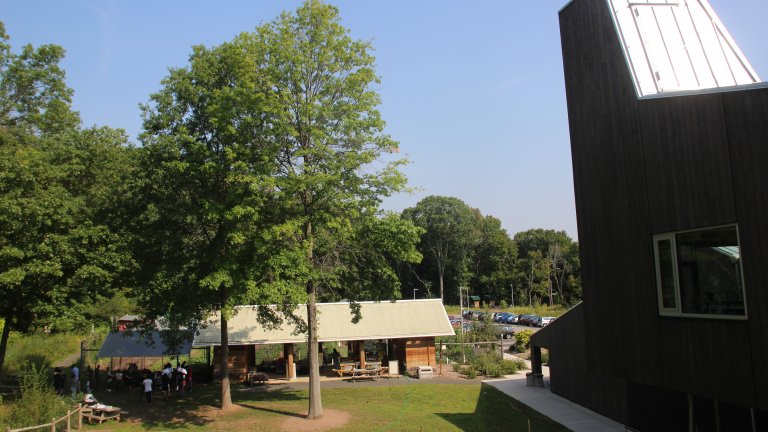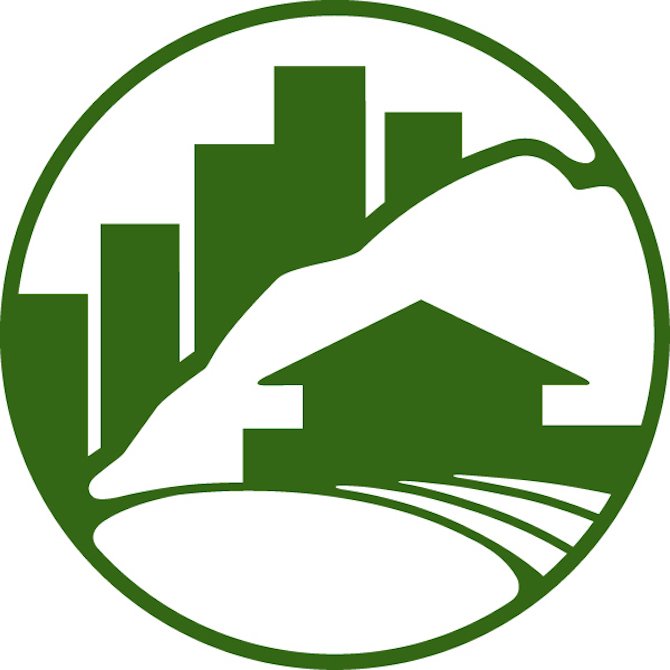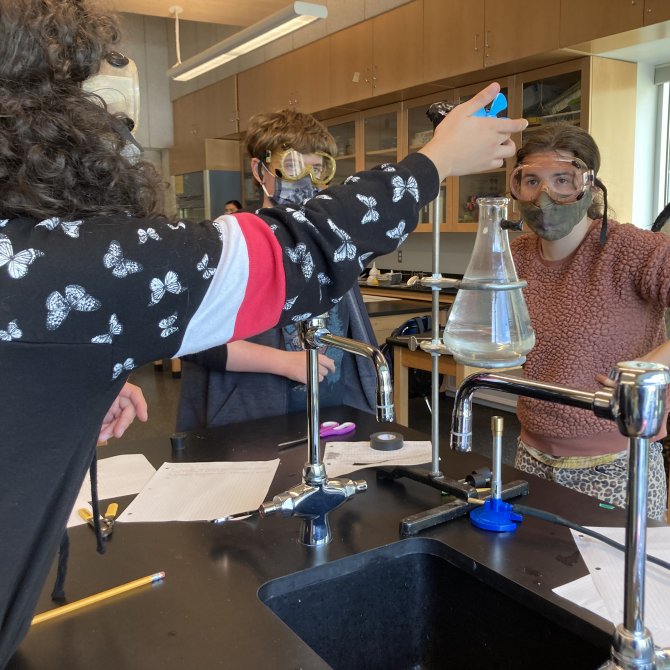
School Context
Launched in 1997, Common Ground is an environmental-justice-themed public charter high school, part of a larger community nonprofit organization that also operates an urban farm and community environmental education center, located in New Haven, Connecticut. The high school’s purpose is to ensure that all students are travelling pathways to college success and continuous learning, powerful leadership for a just and sustainable world, meaningful life-sustaining careers, and happy, healthy, whole, sustainable lives. We are a small, racially and culturally inclusive community of 230 students, grades 9 to 12; 70% of students come from the City of New Haven, and 30% from surrounding towns. Our students graduate at rates consistently above the state average (95% 4-year graduation rate in 2020, in the midst of the pandemic), and more than 90% of our graduates earn admissions to college.
Curricular Context (Grade Level, Subject Area)
Over the last five years, Common Ground teachers, students, families, and community partners have worked together to create a four-year progression of experiences that starts with an interdisciplinary, place-based “core” in grades 9 and 10, and opens up space for students to pursue their own passions and pathways in grades 11 and 12. In this sense, Core 9 is the foundation for the the rest of students' experiences at Common Ground. Ninth graders have three classes that make up the “inner core” of their interdisciplinary studies: English, social studies, and science & health. Additional classes, like Algebra I and Biology, are less deeply integrated but share common systems, themes, and a few key experiences. One important theme we investigate throughout the year is the different levels of human needs, and how systems can provide or deny opportunities for people to meet these needs. Each Core 9 unit ends in an event or product for a public audience. We begin with a familiar audience in our first, basic-needs-focused unit, which culminates in a family food night where students, staff, and families share food and learn together as students present the results of their investigations into food, how we create it, and how it creates us. In collaboration with Teaching Our Cities, we are focused on developing an entirely new culminating project for our final unit.
This project profile was created by Kevin Sinusas, working in partnership with colleagues at Common Ground High School, Common Ground's Schoolyards Program, and Teaching Our Cities.
Environment

Common Ground is located on 20 acres of city park land, at the base of a large forested state park, within the City of New Haven. This setting is a unique one – but unit four of our ninth grade interdisciplinary core engages with this site in a way that is transferable to other school environments. For this model project, we focus especially on resources that are accessible to nearly all schools: nearby trees and streets, younger students at the school site (or a nearby school), and our own school building and staff.
- Younger Students - NatureYear Program
- School and Nearby Built Environment - Energy Production and Usage
- Immediate Natural Environment - Trees of West Rock State Park
- Unique Assets of our Site - Our Farm and Our People
The name of this unit is the short description of our school that’s also captured in our logo: A School, On a Farm, In the Forest, In the City. One goal of this unit is to highlight the fascinating hidden complexity of both the exceptional and the mundane features of this unique site. We explore not just our geothermal heating and cooling system, but also our oil-burning furnace. We learn from our Food Justice Education Coordinator – a position that may only exist at Common Ground – and also our nurse and our facilities maintenance person. We collect data in West Rock Ridge State Park that surrounds us, and from our parking lot and bus stop. Our goal is that students increase their sense of ownership and investment in our school through their engagement with these and other features of our environment.
Expectations
In this project profile, we are working to model a specific approach to project-based learning -- one that helps all student reach toward high academic standards, and that meets students where they are.
Our culminating projects do not assess all learning from the unit
This project is the culminating experience for several different courses, with more content standards and learning outcomes than can be usefully listed here or meaningfully assessed in any single performance task. Attempting to have students demonstrate everything they've learned through one project can decrease depth, choice, and authenticity. Instead, this project sets the expectation that all students develop and demonstrate mastery in a small number of prioritized skills. The application of these skills connect to some but not all content-area topics learned earlier in the unit, based on students’ individual interests and readiness. All priority content standards will still be assessed, but earlier in the unit instead of as part of this final project. This approach can create powerful opportunities for differentiation.
Some students revise earlier work to reach mastery, others apply learning in new ways
These culminating events and projects solve a persistent problem facing attempts at mastery-based instruction and assessment. They move away from the default model where time-spent-learning is fixed and mastery is variable. They seek to expect and develop mastery for all students by finding a way to vary the time-spent-learning the most important course content. Prior to starting work on the culminating project, the most important new content and skills have already been completely taught and assessed. For the final project, students that didn’t fully master these skills return to the earlier small projects of the courses where they “didn’t quite get it.” They are supported in developing full mastery as they prepare this work for presentation to a public audience. Students who have mastered the essential content and skills of the course explore new intersections between prioritized course content and skills.
Students’ strengths are celebrated, while still supporting and developing areas of relative weakness
Every single student will have at least one of the pieces they create presented to the public audience. As differentiated classrooms and public audiences intersect, an issue that can arise is the real gap in end-product quality between different students. This is especially true in a school like ours that can have students reading and writing at elementary school and college levels in the same classroom. We define different assignment “types” for our projects and require all students to create at least one piece of each type. Having a variety of types enables teachers to then feature a more visual contribution from a student with literacy skill gaps, for example. That student needs the literacy skill practice, so they still are challenged and supported to complete the written assignment, but it may not be the contribution from their overall set of work that’s presented to the public audience.
The interdisciplinary team backwards plans using a content-and-skills matrix
In planning all of our culminating events or projects, we’ll create a matrix with 2-4 prioritized skills identified and arranged as column headers. We’ll then add a variable number of prioritized content topics as row labels. At the intersection of columns and rows are possible student products. Some of these products have been completed during the earlier learning sequences of the unit, while others are entirely new combinations of skills and topics. Struggling students who did not yet master key content and skills are directed to revisit the products begun earlier in the unit in order to continue to develop and revise them until they reach true mastery. While it’s not possible to create all the supports that would be needed for all students for all product possibilities, it is possible to do so for the small number of products that students draft early in the unit and that struggling students return to for the culminating project. For students who have already demonstrated the skills needed to be ready for additional challenge, other product possibilities are left more open-ended, including the option to propose and pursue their own ideas. Each year, new open-ended product possibilities can be added and additional supports can be developed for existing ones, gradually increasing the amount of authentic and supported choice available to students.
Below is this project’s incomplete and rough start of this process, with links to related learning experiences from previous years:
|
PRIORITIZED CONTENT |
PRIORITIZED SKILLS | ||
|---|---|---|---|
|
Visually Representing and Analyzing Data |
Designing Interactive Presentations | Creative Nonfiction Writing | |
|
Fossil Fuels & Energy Transformations |
Connections between Fossil Fuels and Global & Local Health [5] |
Crafting Additional Pages (and Experiences) Linked to the “Buried Sunlight” Children’s Story[6] | |
| Carbon Cycle, Climate Change, & Ecosystem Impacts |
Leaf-Bud Timing Data and Connections to Global Climate Change[4] |
Crafting Additional Pages (and Experiences) Linked to the “Buried Sunlight” Children’s Story[6] | |
| Environmental Justice and Human Health | Air Pollution Data[5] | Pig Lung and Model Lung Demonstrations[2] | Crafting Additional Pages (and Experiences) Linked to the “Buried Sunlight” Children’s Story[6] |
| Environmental Justice and Human Health, Continued | Exercise Physiology with Simulated Asthma[3] | Crafting Additional Pages (and Experiences) Linked to the “Buried Sunlight” Children’s Story[6] | |
| Additional possible topics from the earlier version of this unit | |||
These activities are linked to the following national science and health standards:
[1] - HS-PS3-3. Design, build, and refine a device that works within given constraints to convert one form of energy into another form of energy.
[2] - HS-LS1-2. Develop and use a model to illustrate the hierarchical organization of interacting systems that provide specific functions within multicellular organisms
[3] - HS-LS1-3. Plan and conduct an investigation to provide evidence that feedback mechanisms maintain homeostasis.
[4] - HS-ESS3-5. Analyze geoscience data and the results from global climate models to make an evidence-based forecast of the current rate of global or regional climate change and associated future impacts to Earth systems.
[5] - NHES-2.12.6. Evaluate the impact of technology on personal, family, and community health.
[6] - NHES-8.12.4. Adapt health messages and communication techniques to a specific target audience.
Exhibition
On-Location Learning Stations
Students will create educational content to be delivered to anyone visiting our site at a number of “On-Location Learning Stations.” Each year new content will be added to existing stations and some new stations will be created. The student-created content will include the following categories:
Digital experiences triggered by QR codes including, for example, videos, infographics, and interactive slideshows
Physical cards that guide visitors on short learning experiences that have them interacting with something at that location, with the possibility for students to attach objects or tools for visitors to engage with.
Two Parallel Audiences
Two distinct heights for the stations with “sprout” or “tree” symbols will be used for students to explicitly identify the intended audience for their learning experiences:
- Adolescents and adults
- Younger children
Of the three or more skill-focused products students are creating, at least one will need to be intentionally designed for each audience type.
Experience

People- and Partner-Focused Experience: Collaborating with elementary-age students and Harvard ecologists to monitor effects of climate change on the trees right outside our school
This learning experience has two key components, the sequence of which has yet to be determined. One is for our high school students to read a children’s story about fossil fuels and climate change, called “Buried Sunlight,” to the elementary-age children in our organization’s NatureYear program. In addition to reading the story, our high school students will also create and present additional pages based on their in-class research as well as live, engaging demonstrations that illustrate important concepts of the existing pages.
The other key component of this experience is participation in a citizen science project called, “Buds, Leaves & Global Warming” by Harvard Forest’s Schoolyard Long-Term Ecological Research Program. In this project, we will collect data about the timing of leaf bud formation to contribute to a regional database used by real working scientists studying how warming global temperatures have caused leaf buds to form earlier and earlier in the season. At the beginning of this project, our high school students will collect data with the younger NatureYear participants, teaching them how to do so independently. Then, for about one month, the NatureYear students will collect data on their own, reporting their results back to the high-schoolers at the conclusion of that month.
Place-Focused Learning Experience: Designing and conducting experiments to collect data relating fossil fuel combustion to local air quality and differences in asthma problems
Traditional Classroom/Laboratory Experience: Engineering and refining working miniature fossil fuel (and alternative energy) power plants capable of lighting up small light bulbs
- Interactive virtual lesson to prepare students for the challenge
- Actually building, testing, and refining the devices in the lab
Creative Nonfiction Experience: Analyzing environmental creative nonfiction texts and understanding how the technical aspects of fiction can make nonfiction narratives more compelling.
Reflections
This unit has not yet been implemented as planned; we look forward to doing so next Spring and learning from the experience.
